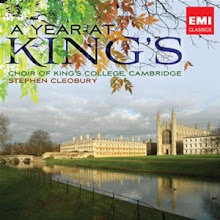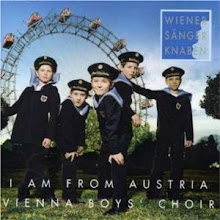Odds and ends
Fashion
A question occurred to me the other day and I still have not found a good answer. I was watching one of my choral dvd’s and started thinking about the boys’ costumes and whether there is a difference between those worn by Church of England choirs and those by Catholic church choirs. I went to Wikipedia and, while there was a lot of information about both types of churches, they didn’t say anything about the choirs. I looked at a list of Catholic churches in England to see which of the choirs whose recordings I have would be on it, but I didn’t see any of them. Winchester cathedral, Westminster Abbey, Ely, Tewkesbury, Saint Paul’s, Saint John’s college and the others, are they all Church of England?
That leaves me with my original question of what do Catholic boys’ choir robes look like?
I may be misunderstanding all of this because it’s never been a part of my world. I gather that C of E is sort of like Catholic lite, or reformed Catholic, but is that the wrong way of looking at it? Do the Catholic choirs record their music?
Inquiring minds want to know. These unanswered little questions bug me, especially if it means that I might, through my ignorance, write something that is somehow incorrect.
Literature
Looking through my old books for something to re-read I picked up one that I’ve read twice but it was several years ago. It was Cry To Heaven by Anne Rice. Written in 1982 this is not a vampire story, it’s not about anything supernatural, or as she likes to say, preternatural. It is a well researched and fascinating tale about Venice in the mid-1700’s, and a boy who has a great singing talent.
This book looks closely at a sad bit of history, the world of the castrati singers of that time, their social status, musical training and careers. It’s a pretty racy story so be forewarned, but Anne Rice is such a masterful writer that she makes that period come alive and you can almost hear and smell and taste Venice. She takes us to a music school in Naples and to the opera houses of Rome. She talks about the teaching methods used back then and shows us the excitement and passion that people felt for opera and the adoration they had for the great singers.
It also contains drama, sex, suspense and revenge, a nice combination in any story.
Music
I started noticing that a lot of the cathedral choir CD’s that I have are from Hyperion records so I took a look at their web site. They have an amazing number of classical music albums to choose from and the cool thing is that if they don’t have one in stock or if it’s out of production they will print you a new copy of it from their archives. I don’t own stock or anything, I just thought that was a nice idea since no choir can keep all of their music in production forever.
----------------------
Did you know…?
The compact disc is a miracle of modern technology. Here are some facts:
They are made principally of injection-molded polycarbonate.
The diameter is 120mm.
They are 1.2mm thick.
They contain up to 680 megabytes of data. This is the equivalent of 250,000 double-sided leaves (500,000 pages) of A4 text (which would be 83 feet high and need 8 trees to make).
The music on a CD is imprinted in the form of pits of varying length on a spiral track 3.52 miles (5.66 kilometers) long.
There are approximately 16,000,000,000 pits 0.11 micro-metres deep.
The largest pit dimension is 3.054 microns; the smallest is 0.833 microns.
The width of the pits is half a micron -- which is the distance a human hair grows in two minutes and a fingernail in seven minutes. It is 700 times smaller than a pinprick.
The space between tracks is 1.6 micro-meters.
Read by a red-light laser beam, the CD plays from the centre to the edge, rotating at a speed varying from 400 times a minute at the beginning to 250 times a minute at the end. This is equivalent to flying round the earth one inch above the surface, up to 400 times a minute, counting every blade of grass on the way.
Your CD is read by the laser beam and makes over 44,000 arithmetical calculations every second in at least two dimensions. It is adding up columns of numbers ('digits'). But many of the numbers are missing because there are thousands of errors on the average CD. Therefore the numbers are added up laterally as well as vertically, enabling the CD-player to fill in the missing numbers by cross-checking them. This is all quite normal and is called 'error correction'.
Thursday, June 11, 2009
Subscribe to:
Post Comments (Atom)













Winchester cathedral, Westminster Abbey, Ely, Tewkesbury, Saint Paul’s, Saint John’s college and the others, are they all Church of England?
ReplyDeleteYes. They started out--once upon a time--as Roman, but are now Anglican. If you're looking into Catholic choirs in Great Britain, try Westminster Cathedral (not Abbey) or the Metropolitan Cathedral of Liverpool (looks like a gigantic starfish, that)...those are probably the UK's two preeminent Roman cathedrals.
I gather that C of E is sort of like Catholic lite, or reformed Catholic, but is that the wrong way of looking at it?
:D Yes and no (a truly Sir Humphrey answer).
It depends on which part of the Anglican Church one is looking at. We are far more inclusive than the Church of Rome--that is, we tolerate a great deal more diversity both theological and in liturgical practice than the Church of Rome.
There are three essential kinds of Anglicans:
* "High Church": the Anglo-Catholics; the High Church (Wakefield Cathedral, York Minster) is deeply involved in reconnecting with the Roman influence on the Church of England; they favour the elaborate ritual and theological rigidness of the Vatican, while still remaining in the Anglican Church.
* "Low Church": the Evanglicals; roughly synonymous to American Lutherans or Presbyterians. The Low Church (Rochester) favour a much more active community presence, and are generally not in line with the High Church's adherence to Roman doctrinal mores.
* "Broad Church": the scientists and liberals; the Episcopal Church of the United States is highly 'broad church'--politically and theologically liberal, active in the community, and generally in line with the sensibilities of the Low Church, but without the heavy emphasis on religious conversion. I am, as a member of TECUSA, a 'Broad Church' Anglican, for example.
So it's Catholic Lite in some respects, but most of us are quite proud to have a distinct identity apart from the Church of Rome...I wouldn't personally describe myself as "Catholic Lite," although the High Church probably could apply that moniker to themselves...
Wow, wordy: sorry! Hope this sates your curiosity somewhat. Coincidentally: I just received a book this morning that might be useful to you: Martin Davie, A Guide to The Church of England...written specifically for non-Anglicans and non-Christians.
BTW: if Liverpool Anglican Cathedral's choir has put out a CD/CDs and you come across them, I'd be very interested--that church is the largest cathedral in Britain and has a magnificently thunderous organ.
ReplyDeleteThanks, that is great info to have. I've heard the terms High Church, Low Church and Broad Church but never seen them defined so clearly. You said it very nicely.
ReplyDelete